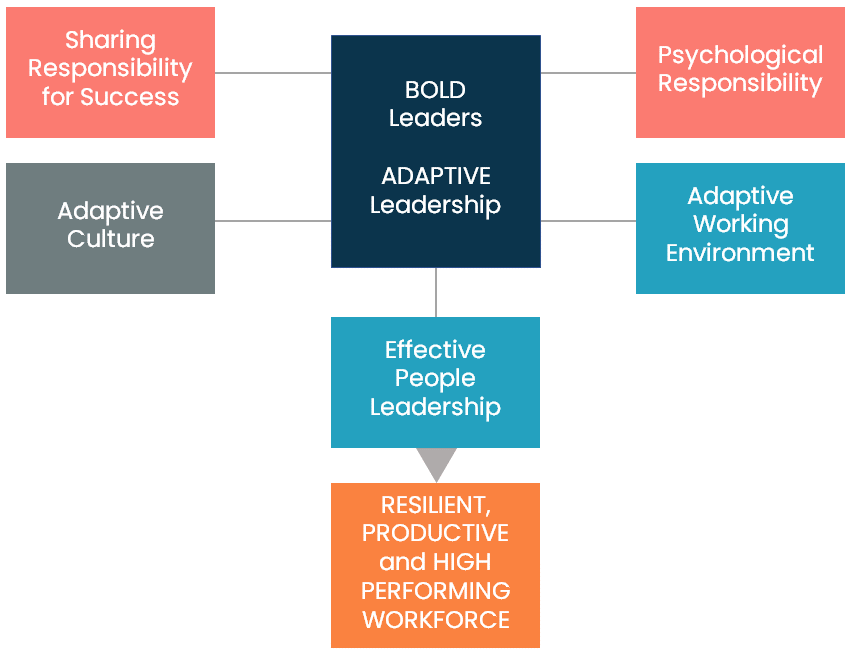Organisational Resilience
What is organisational resilience?
Organisational resilience is the capability of the workforce to be flexible and adaptive enough to respond positively and effectively to internal and external pressures for change, and threats to the organisation.
The characteristics of an adaptive and resilient organisation
- An atmosphere with a real buzz, combined with high level performance
- A capacity of the workforce to respond effectively to internal and external pressures for change faster and more effective than competitors
- A capacity to renew and regroup rapidly
- A capacity to determine their own future and shape their own destiny
- A capacity to conduct long term strategic thinking and planning whilst delivering high quality products and services on a daily basis.
The approach
The approach to strengthening organisational resilience against risks is to create the working environment that provokes individuals in the workforce to feel psychologically well. Only when people feel well, and have clarity of mind, will they be able to think clearly about the strategies required to respond effectively to risks before they become threats. Psychologically well people will, also, have the strength and flexibility to adapt to changing circumstances without diminution on their performance.
There is a direct link between individual psychological wellbeing and performance. High level performance comes from people who can focus and concentrate on their work. Concentration is key. People can have all the skills, knowledge and experience possible, but if they cannot concentrate, these attributes are a waste of time. Dealing with physical interference with concentration is relatively straight forward. Dealing with psychological interference is more complex, requiring attention to be paid to culture, leader and manager behaviour and the working environment.
People concentrate when they have clarity of mind. Once they have this they can contribute to organisational resilience when they feel so psychologically well they are energised, highly motivated and engaged, and want to see their organisation achieve, and maintain, great success.
The workforce is, also, more willing to ‘go the extra mile’ because of their engagement with achieving success for the organisation. They do what it takes to be successful. Organisational success rubs off on individuals. It is a sensation that makes people feel so great they want to repeat the sensation over and over again.
Organisational success is realising full and true potential rather than simply measuring certain elements. People respond to fulfilling potential more than simply making profits or dominating maker share. People dis-engage when they see inefficiencies or waste, both of which can be seen in organisations that focus only on profits, financial turnover and market share. Inefficiencies are not tolerated in organisations that aim to achieve their full and true potential.
Wellbeing and Performance Agenda
This agenda is a series of steps to be taken to convert the organisation into a highly resilient and successful place to work – a fabulous organisation.
Each organisational element is directed towards provoking individuals to feel psychologically well, and to perform at their peak. With the right organisational elements in place, the workforce will be motivated to be resilient against events and behaviours that arise within the workplace. However, with the right elements in place, adverse events and difficult behaviours, for which personal resilience is required, will rarely arise, and when they do, they’ll be overcome more easily.
The WellBeing and Performance Agenda represents a systemic approach to organisational development. All elements need addressing. No single element, on its own, will bring about the desired effect of creating and sustaining a resilient organisation.
Step 1: placing the psychological wellbeing of the workforce at centre stage
This means that members of Boards of Directors need to consider the impact of all their decisions on the psychological wellbeing of the workforce, which they will probably find challenging - dealing with people is less certain and more time consuming than dealing with more technical issues. The change of focus, from the technical to the adaptive, is an essential first step to stronger resilience and the greatest success for the organisation.Placing the psychological wellbeing of the workforce centre stage is the first step to organisational resilience, health, wellbeing and performance.
Step 2: the development of leaders and leadership
Most organisations aren’t led, they are managed. People need leaders; processes need managers. Therefore, to create a positive culture requires leaders who understand people and have the ability and capability to deal with uncertainty.
Leaders have a role to create and sustain a psychologically healthy organisation in order to guarantee a successful business.
Their task is to create the conditions in which individuals can thrive, and do justice to their intelligence, which, collectively, is far greater than that of the leaders.
Leaders need to implement two principles
- the overriding principle of sharing responsibility for the future success of the organisation amongst everyone in the organisation. Once this principle is in place, it will result in the reduction of fear, and enables individuals to feel psychologically safe; and
- Taking responsibility for psychological wellbeing, which relies on people speaking out about their situation and any threats to their psychological wellbeing. The obligation on the workforce is to look after their own psychological wellbeing as well as that of everyone else. This has the effect of moderating behaviour and focusing on those behaviours known to reduce and eliminate the risk of distress in people – Intelligent Behaviours.
Leaders then implement the elements that create a positive and supporting work culture, which are:
- Purpose
- Vision
- Cultural values
- Corporate values
- Ethical values and
- Cultural rules
These combine together to create a supportive culture.
Step 3 : Ensure the working environment supports individual concentration, as concentration is the basis of performance
This covers topics such as a healthy environment, good IT and technology, workplace ergonomics and workplace management.
Step 4: Leaders ensure the workforce is resilient
Although the emphasis is to prevent the workforce from needing to be resilient. Nevertheless, personal resilience will be needed if the organisation needs to become resilient because of an external or internal threat, which will have a ripple effect on individuals.
Implementation will be assisted by the development and implementation of a
- Charter for Wellbeing and Performance
- Leader’s Code which contains the behaviours needed to ensure the organisation remains resilient to threats.

This article and accompanying tips have been provided for FICM by leading psychologist Dr Derek Mowbray.
To find out more about Strengthening Organisational Resilience, read Derek ’s Guide to Organisational Resilience.
To find out more about in house programmes for Organisational Resilience, email barbara.leigh@mas.org.uk, or download a pdf of all our development programmes.
More information can be found in the MAS Article Library, or why not try the MAS Questionnaires.
Want to know more?
Browse our Wellbeing resources.


